Passionate about calves: we interviewed highly committed women involved in rearing calves – part 1
26. Mai 2025 — General InformationIt is well known that women often take care of the calves on dairy farms. And also that they generally do so with considerable enthusiasm and expert knowledge. We spoke to several of them and were delighted to encounter such a wealth of expertise, commitment and attention to detail.
Daniela Schönberger: Healthy, happy calves – the cornerstone of a successful dairy farm
The accommodation for her calves is still somewhat provisional at the moment, but with her feeding plan, a lot of love and dedication, Daniela Schönberger is achieving daily weight gains of over 1,000 g. Daniela runs a dairy farm with her family in the Westerwald region, with 300 dairy cows and around 100 calves to feed. Around 45 are kept in single or double pens and are fed by a MilkTaxi. The aim is to transfer the animals to the barn after a fortnight, where they can then feed from calf feeders.

The various calf hutches are spread around the farm grounds. Daniela has to walk quite a distance to provide the calves with milk. It's really tough work in bad weather, but Daniela sticks to her extensive feeding schedule: newborns are given 4 litres of colostrum. The second feed is also colostrum.
The calves are subsequently fed their mother's milk mixed with CMR. The calves are then fed only milk replacer from the fourth day onwards. Daniela feeds three litres of CMR three times a day and increases this to four litres as soon as she sees that the calves are no longer satisfied. The amount is gradually reduced to two litres by day 80, until the calves receive no milk at all from day 105 onwards.
Daniela would really like to feed her calves ad libitum, but the conditions on her farm do not allow this yet – especially with regard to hygiene and milk that is cold in winter. However, at 12 litres per day, she is already very close to this target and does her calves a real favour with a long weaning period, as the forestomachs do not fully develop until after four months.

Growth rates also prove Daniela right: she weighs her calves at birth, when they are moved to new pens and after weaning. The gains of between 1,000 and 1,200 grams are excellent results for her feeding programme.

Watch our video interview on YouTube to discover the advantages Daniela sees in the CalfExpert feeder and how she plans to design her ideal calf barn.
Marianne Kohlmeyer: Healthy calves boost farm profits
Happy calves that grow well and are in excellent health are a matter close to the heart of calf coach Marianne.

Marianne cares passionately for her calves on the Lührshof farm in Lower Saxony. Alongside her practical work, she puts a lot of energy into the strategic direction of calf rearing – above all, she never stops asking questions. Which is the right teat? How do I design an efficient and healthy barn area? What should I feed when, and how much? What automation options are available...?
Not only has she significantly optimised how she raises her calves, she has also built a business around it. She shares her expertise at www.kaelbercoach.de and on her social media channel (@kaelbercoach).
Marianne's primary objective is to achieve high daily weight gains in her calves. This is because it has been proven – and is also consistent with Marianne's practical experience – that calves that grow well become high-yielding, healthy cows. Calves that gain less than 1,000 g a day are therefore not integrated into the existing dairy herd.
Marianne's calves are fed whole milk (acidified and enriched with minerals) and water ad libitum from the first day of life. She also offers them calf milk replacer from the second day onwards. The animals are weaned after an average of twelve weeks.

Marianne is happy to invest the additional cost of around EUR 50 per calf: her calves do not suffer from diarrhoea and do not experience any problems during weaning. Our MilkTaxi is a great help here, as it eliminates the hassle of carrying buckets, and its many useful functions, such as heating and stirring, make her work much easier.

Marianne likes to keep her animals in pairs or groups. The calves are grouped together after between 14 and 21 days. It is important to her to have fixed groups with as little fluctuation as possible. This significantly reduces stress for calves and discourages them from suckling each other. Watch our YouTube video for more details about this and how Marianne's barn concept works, and how it makes her work easier.
Konstanze Rohwer: As close to nature as possible
Konstanze trained as a hotel manager and chef. When she started, she brought with her a valuable outside perspective on her husband's farm. After taking over complete responsibility for calf management in 2011, she attended specialist lectures and studied technical literature to further her knowledge. With the birth of her own children, she quickly realised that the closer calf rearing is to natural conditions, the healthier and more resilient the calves grow.

Konstanze has therefore long advocated ad libitum feeding – initially pasteurised whole milk and, after transfer to the new barn, whole milk mixed with up to 30% CMR. The automated feeder is a huge help in this regard: CalfExpert feeds each animal individually, the feed curves can be programmed precisely and the weaning phases can be designed to be gentle and controlled. This enables Konstanze to achieve growth gains of around 1,000 g.

It may sound counterintuitive at first, but her experience shows that calves that are weaned quickly are actually more costly than those that are weaned slowly. She can also back this up scientifically: a study conducted by the Neubrandenburg University of Applied Sciences confirms her experience. The costs of veterinary care and medication for calves that are only fed for 8 weeks far exceed the additional costs incurred by feeding them for longer and more intensively.
Konstanze feeds her calves milk for 100 days and finds this works very well. This was certainly one of the reasons why she was awarded second place in the MSD Animal Health Prize in 2019. Congratulations, Konstanze!

Watch our YouTube video to learn why Konstanze is very happy with her new calf barn – but also where it reaches its limits – and what challenges Konstanze will have to deal with in the near future as a result of her success.
Healthy calves, stress-free processes
Healthy calves are paramount for all three women featured here: not only do they make their work that much easier, they also make it much more enjoyable. This is a factor that should not be underestimated when it comes to improving quality of life. And, most importantly, it's the best foundation for a farm's financial performance.
Dear Daniela, Marianne, and Konstanze, thank you so much for allowing us to take a peek into your farms and your work, and for sharing your experiences with us. We wish you continued enjoyment and success with your calves.






